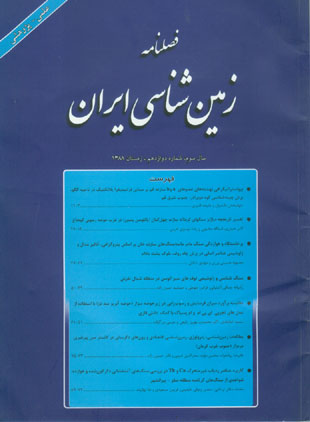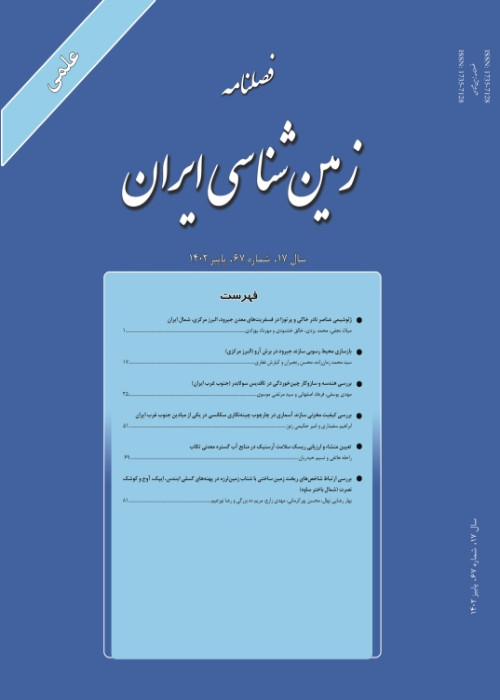فهرست مطالب

فصلنامه زمین شناسی ایران
پیاپی 12 (زمستان 1388)
- 96 صفحه،
- تاریخ انتشار: 1388/12/20
- تعداد عناوین: 7
-
-
صفحات 3-11اهمیت سازند قم و گسترش وسیع آن در زون ایران مرکزی و اختلاف نظر در مورد مرز الیگوسن– میوسن در ناحیه الگو، سبب شد تا گسترش چینه شناسی فرامینیفرهای عضوهای a و b سازند قم درکوه دوبرادر در جنوب شرق شهر قم مورد بررسی قرار گیرد. عضوهای a و b سازند قم در برشمورد مطالعه با 174 متر ضخامت از سنگ آهک، سنگ آهک ماسه ای، مارن، مارن ماسه ای، و میانلایه هایی از ماسه سنگ و کنگلومرا تش یکل یافته است. شناسایی و بررسی گسترش چینه شناسی فرامینیفرهای پلانکت یک عضوهای a و b و تعیین سن نهشته ها با برداشت 72 نمونه منجر به شناسایی 7 جنس و 12 گونه از آنها شد. در میان گونه های شناسایی شده حضور Globigerinoides primordius از قاعده عضو a)نمونه شماره 2(و Globigerinoides triloba از نمونه شماره 6 در عضو a و تکرار حضور آن در عضو b به تعداد زیاد و نیز حضور Paragloborotalia kugleri تا قسمت های میانی)نمونه شماره 42 (، سن ایکتانین را برای نهشته های عضوهای a و b مشخص می سازد.
کلیدواژگان: سازند قم، عضوهای a و b، برش الگو، فرام ن فرا پلانکتک، جنوب شرق قم -
صفحات 13-26به منظور تفسیر توالی دیاژنزی و تاریخچه پس از رسوب گذاری سنگهای کربناته سازند چهل کمان)پالئوسن پسین(، دو برش گرماب و جوزک با ضخامت های 95 و 40 متر در شمال غرب و جنوبغرببجنورد، غرب حوضه کپه داغ، مورد مطالعه قرار گرفته است. فرآیندهای دیاژنزی موثر بر این سنگهاشامل میکریتی شدن، سیمانی شدن، نئومورفیسم، فشردگی، انحلال، شکستگی و پرشدگی رگه ها، سیلیسی شدن و دولومیتی شدن است. نتایج آنالیز عنصری نشان دهنده آن است که مقدار Fe و Mn با یکدیگر همبستگی مثبت و با عناصر Sr و Na همبستگی منفی دارند. بر اساس شواهد پتروگرافی و آنالیز عنصری، توالی پاراژنزی سنگهای آهکی سازند چهل کمان در چهار محیط دریائی، آب شیرین، تدفینی و بالاآمدگی تفسیر و طی سه مرحله ائوژنز، مزوژنز و تلوژنز، رسوبات را تحت تاثیر قرار داده اند. امید است نتایج این مطالعه در تفسیر تاریخچه پس از رسوب گذاری در مقیاس محلی و ناحیه ای مؤثر باشد.
کلیدواژگان: آنالیز عنصری، توالی پاراژنزی، سازند چهل کمان، سنگهای کربناته، غرب کپه داغ -
صفحات 39-50توف های سبز سازند کرج (ائوسن) در منطقه شمال تفرش شامل توالی ضخیمی از توف کرستال توف و ویتریک توف می باشند. مطالعات میکروسکوپی و آنالیزهای میکروپروب نشان می دهد که مهم ترین کانی های اصلی موجود در این توف ها عبارتند از پلاژیوکلاز نوع آندزین و لابرادوریت، پیروکسن نوع اوژیت، پرهنیت، پومپلیئت و کانی های رسی می باشند. با توجه به اندازه و ریخت شناسی شاردهای شیشه ای موجود در این توف ها به نظر می رسد توف های منطقه شمال تفرش در شرایط دریاچه ای کم عمق تا هوایی در حجم زیاد فوران کرده اند و با توجه به ضخامت زیاد آنها قبل از چین خوردگی ها دچار آلتراسیون شدید شده و بویژه در بخش های قاعده ای تحت تاثیر دگرگونی تدفینی قرار گرفته اند.
کلیدواژگان: تفرش، توف سبز ائوسن، دگرگونی تدفینی
-
Pages 3-11In this study, the stratigraphic distribution of planktic foraminifera of a and b Members of the Qom Formation, in Kuh - e -Dobaradar, southeast Qom has been investigated. The thickness of a and b Members in examined section is 174 m and consists mainly of marl, sandy marl and sandstone and conglomerate. With respect to importance of the Qom Formation and its vast distribution in different parts of central Iran zone and different ideas about its age, the investigation about the age of a and b Members of the Qom Formation in this area is necessary. For this purpose micro paleontological studies on 72 samples in examined section led us to recognition 7 genera and 12 species from 4 families of planktic foraminifera. According to occurrence of Globigerinoides primordius from the base of a Member (sample no. DB- 2) and Globigerinoides triloba, from sample no. DB- 6, and Paragloborotalia kugleri (sample no. DB- 42), the sediments of the a and b Members probably belong to Aquitanian.
-
Pages 13-26For interpretation of post depositional history of carbonate rocks of the Chehel-Kaman Formation (Late Paleocene), two stratigraphic sections were measured at Garmab and Jowzak in the NE and SE of Bojnord, with the thickness of 95 and 40 meters respectively. Diagenetic processes affected these rocks include micritization, cementation, neomorphism, compaction, dissolution, fracturing and vein filling, silicification and dolomitization. Elemental analysis data show the positive covariance between Fe-Mn values and negative covariance between these elements and Sr-Na values. Paragenetic sequence of these rocks has been interpreted to be operated in four environments including marine, meteoric, burial, and uplifting based on petrographical evidences and elemental analysis. These processes have taken place during three stages including eogenesis, mesogenesis, and telogenesis. We hope that our data can be used for evaluation of post depositional and burial history in local and regional scale.
-
Pages 27-37Permian siliciclastic/carbonate successions of the Khan Formation, located in Chahroof section, Posht-e-Badam block in Central Iran, consist mainly of medium to thick bedded sandstones which their tectonic provenance and parent rocks were studied using petrography, modal analysis as well as geochemistry of major elements. Petrographical evidence, such as, well rounded monocrystaline quartz with straight extinction, lacking of plagioclase and ferromagnesian minerals, existence of rounded zircon and tourmaline imply craton interior and sediment recycling provenance. Moreover, using modal analysis data and plotted on (Qm95.5, F0.8, Lt3.6) and (Qt99.1, F0.8, L0) diagrams support this provenance interpretation. Based on geochemical data in discriminating tectonic diagrams, Khan Formation sandstones are deposited on a continental passive margin. High value of weathering index (CIW' = 98.18) accompany with compositional maturity show influencing of humid climate in the provenance.
-
Pages 39-50Thick sequences of Karaj Formation green tuffs, with the age of Eocene, are dominant in north of Tafresh, Central Iran. These pyroclastics consist mainly of lithic tuff, crystal tuff and vitric tuff. EPMA analysis as well as thin section petrography indicates that they are composed of quartz, plagioclase, K-feldspar and secondary minerals such as chlorite, albite, analcime, epidote, prehnite and pumpellyite. In addition to the above mineralogical assemblages, the basal tuffs contain a variety of glassy fragments and shards with different size and shapes mainly in the form of curved, v- shape and crescent. The size and morphology of glass shards at the base of pyroclastics show that the magma has been saturated by water steam resulting in a thick foam like magma at the top of the chamber near the vent (most possibly a fissure like or a caldera shape). Whereas, the mineralogical assemblage in particular the secondary minerals suggests that the tuffs, in their basal horizons, have undergone a very low grade metamorphism in the zeolite and prehnite- pumpellyite facies. It is likely that the considerable thickness of tuff series is responsible for such a burial metamorphism in the north Tafresh area.
-
Pages 51-61Sezar sub-Basin is a part of the Dez-dam catchments area (Zagros Zone, Lorestan Province), with an area of 3370 Km2 and 267 Km periphery length. In this study, erosion potential and sediment- yield of the basin was estimated by EPM and MPSIAC methods using GIS data. The values of the main parameters in the MPSIAC and EPM models in the sub basin were evaluated in a GIS environment. Then, the potential and annual sediment yields were calculated by combination of the main parameters in EPM and MPSIAC methods. In both methods, 80% of the study area is in the high- and very high – erosion potential classes, which are located in southwestern part of the area, where Pabdeh, Gurpi and Gachsaran formations are present. At the next step, clustering erosion in potential and sediment yield of the basin were estimated by fuzzy and clustering methods. The annual sediment in MPSIAC and EPM models were 2985584 and 5205725 m3, respectively. The results of clustering method show the class boundaries in the basin are transitional. Also comparison of three methods show an over-estimation tendency, however, MPSIAC results are more reliable.
-
Pages 63-75Porphyry copper deposit of Dareh-zar is located in the Tertiary magmatic zone of Urmieh-Dokhtar. The emplacement of porphyry stock of Dareh-zar occurred along the axis of an anticline, with a NW-SE trend. Host rocks consist of Eocene volcanic and volcano-clastic rocks. Lithological composition of Dareh-zar porphyry pluton is quartz-monzonite. It is cut by masses of diorite and granodiorite porphyry and related dykes. Due to the cutting of supergene mineralization zone by diorite and granodiorite dykes, they can be considered as post mineralization dykes. Granodiorite dykes are less altered in comparison with dioritic dykes so are the youngest intrusion in area. Action of reverse faults resulted in more sever erosion on hanging wall blocks and therefore potassic alteration zone appears in this part on the surface. The main portion of the propylitic alteration zone is located in the host rocks. Supergene zone is located as lenses in phyllic alteration zone. Dioritic dykes intruded simultaneously with Dareh-zar porphyry and are mineralized, therefore, they are affected by supergene processes but they don’t have considerable amounts of copper. Parent magma of Dareh-zar porphyry mass was high K calc-alkaline with a slight tendency toward shoshonite. The study of variation pattern of REE in this mass indicates poor relative differentiation from LREE to HREE [(La/ Yb)N =0.26-3.71]. Remarkable enrichment of LILE is observable in this pluton which indicates magmatic contamination with crustal rocks, therefore, this result proved with negative anomaly of Nb. This pluton located in an active continental margin and is related to evolved post collisional arcs.
-
Pages 77-89It has long been recognized that the TAS diagram is not robust in classifying altered volcanic rocks and proxies using more immobile elements have been developed for that purpose. Through recent years, researchers introduced new discrimination plot based on immobile Th – Co elements as proxies of K and SiO2 are very useful to classify metamorphosed and weathered rocks especially in volcanic arc successions. The application of different elements, especially Th and Co, in classification of the Cretaceous volcanic rocks in Saghez – Piranshahr area is examined here. Based on petrographic studies, these rocks are andesites and basaltic andesites. Also sub-volcanic and related pyroclastic rocks accompany them. Low grade metamorphism in green schist facies and weathering process are affected studied rocks. Secondary minerals, such as epidote, chlorite, tremolite, actinolite, prehnite, pumpellyite, sphene, iron oxides, calcite and quartz, observed and are products of low grade metamorphism and alteration. Microprobe analysis reveal that plagioclase composition became homogenized (albitization). Rare K-Feldspar crystals are formed within rock matrix. Cretaceous volcanic units in Saghez – Piranshahr area formed in a volcanic arc due to obvious negative Nb anomalies in spider diagrams normalized to MORB. Samples show scattered patterns by using ordinary classification methods which use main oxides or some trace elements, therefore their nature and type could not be clearly recognized. But, Th-Co diagram let us to classify them as calc-alkaline basalts, basaltic andesites and andesites. Therefore, Th and Co are efficient tools for recognition of magma nature and rock types in such metamorphosed and weathered rocks.


